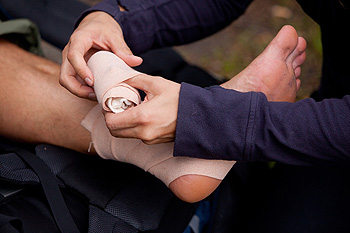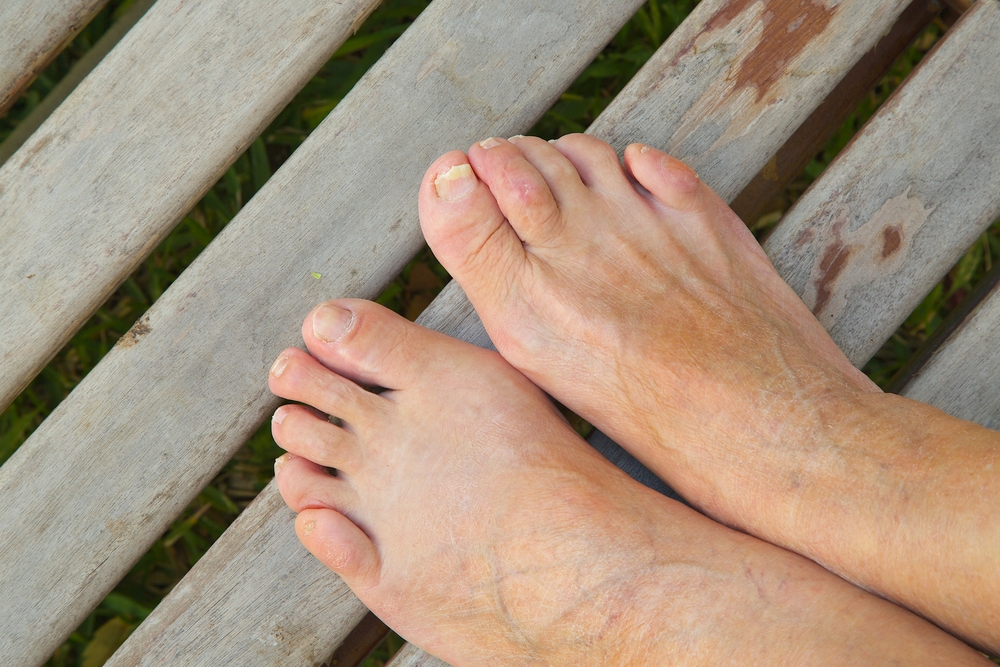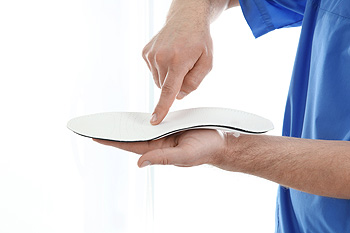Items filtered by date: April 2023
Methods to Improve Ankle Stability

For anyone who has sprained an ankle, the necessity for strengthening the joint after healing is important. A weakened ankle joint increases the risk of another sprain, which can evolve into chronic ankle instability. A symptom of an unstable ankle is the feeling that the joint gives way during normal activity, which is often a sign of an overstretched ligament. Treatment options include performing a series of neuromuscular exercises to strengthen the ankle joint, along with wearing a protective brace for stability. If the ligament is still too loose, surgery becomes an option. The ligaments, which hold the joint in place, can be shortened and tightened, or in some cases, replaced. Ankle instability can also cause problems with muscle coordination, and for this reason strengthening exercises may be helpful. If you have experienced a recurring ankle stability problem, it is suggested that you consult a podiatrist for a full examination of the joint and the right treatment options for you.
Although ankle sprains are common, they aren’t always minor injuries. If you need your ankle injury looked at, contact Dr. Richard T. Bauer from Summit Foot & Ankle. Our doctor can provide the care you need to keep you pain-free and on your feet.
How Does an Ankle Sprain Occur?
Ankle sprains are the result of a tear in the ligaments within the ankle. These injuries may happen when you make a rapid shifting movement while your foot is planted. A less common way to sprain your ankle is when your ankle rolls inward while your foot turns outward.
What Are the Symptoms?
- Pain at the sight of the tear
- Bruising/Swelling
- Ankle area is tender to touch
- In severe cases, may hear/feel something tear
- Skin discoloration
Preventing a Sprain
- Wearing appropriate shoes for the occasion
- Stretching before exercises and sports
- Knowing your limits
Treatment of a Sprain
In many cases, the RICE method (Rest, Ice, Compression, and Elevate) is used to treat ankle sprains. However, you should see a podiatrist to see which treatment option would work best with your injury. In severe cases, surgery may be required.
It is important to ask your doctor about rehab options after you receive treatment for your injury. Stretching, strength training, and balance exercises may help the ankle heal while also preventing further injury.
If you have any questions, please feel free to contact our office located in Latham, NY . We offer the newest diagnostic and treatment technologies for all your foot care needs.
Wounds That Don't Heal Need to Be Checked
Causes and Risks of Diabetic Foot Ulcers

Diabetics are often at risk of other conditions that negatively affect their feet. These include peripheral neuropathy, which renders the feet numb, and peripheral artery disease, which slows the healing process. Both are the result of maintaining high blood sugar levels. Any sore or bruise on the feet that are not tended to immediately can easily become ulcerous. Termed foot ulcers, these open sores or wounds are usually found on the sole of the foot or the bottom of the big toe. Unless the diabetic’s feet are checked daily for such injuries, they can easily go undetected. An open foot ulcer increases the chance of developing an infection, which in turn can involve deeper layers of the skin, muscles, tendons, bones, and joints. In the most severe cases, surgery is required and loss of a limb is a possibility. If you are at risk of developing diabetic foot ulcers, it is suggested that you make an appointment with a podiatrist who is trained to deal with diabetes-related problems.
Diabetic foot care is important in preventing foot ailments such as ulcers. If you are suffering from diabetes or have any other concerns about your feet, contact Dr. Richard T. Bauer from Summit Foot & Ankle. Our doctor can provide the care you need to keep you pain-free and on your feet.
Diabetic Foot Care
Diabetes affects millions of people every year. The condition can damage blood vessels in many parts of the body, especially the feet. Because of this, taking care of your feet is essential if you have diabetes, and having a podiatrist help monitor your foot health is highly recommended.
The Importance of Caring for Your Feet
- Routinely inspect your feet for bruises or sores.
- Wear socks that fit your feet comfortably.
- Wear comfortable shoes that provide adequate support.
Patients with diabetes should have their doctor monitor their blood levels, as blood sugar levels play such a huge role in diabetic care. Monitoring these levels on a regular basis is highly advised.
It is always best to inform your healthcare professional of any concerns you may have regarding your feet, especially for diabetic patients. Early treatment and routine foot examinations are keys to maintaining proper health, especially because severe complications can arise if proper treatment is not applied.
If you have any questions please feel free to contact our office located in Latham, NY . We offer the newest diagnostic and treatment technologies for all your foot and ankle needs.
Hammertoe and Flip-Flops

Hammertoe is a particular condition of the foot in which the joints of the toes point upward in a “v” shape at the center of the toe. The toe ultimately has a hammer-like shape. This condition can be caused by many different things. Specifically, wearing flip-flops may contribute to the onset of hammertoe. When an individual wears flip-flops, they must essentially scrunch up their toes to keep the flip-flop on their feet. This is an unnatural and strenuous task for the toes. As a result, the muscles in the toes might experience an imbalance. Hammertoe can result. If you are someone that wears flip-flops frequently, you might be at an increased risk of developing foot conditions such as hammertoe. It is suggested that you reach out to a foot care specialist such as a podiatrist to receive treatment or attention.
Hammertoe
Hammertoes can be a painful condition to live with. For more information, contact Dr. Richard T. Bauer from Summit Foot & Ankle. Our doctor will answer any of your foot- and ankle-related questions.
Hammertoe is a foot deformity that affects the joints of the second, third, fourth, or fifth toes of your feet. It is a painful foot condition in which these toes curl and arch up, which can often lead to pain when wearing footwear.
Symptoms
- Pain in the affected toes
- Development of corns or calluses due to friction
- Inflammation
- Redness
- Contracture of the toes
Causes
Genetics – People who are genetically predisposed to hammertoe are often more susceptible
Arthritis – Because arthritis affects the joints in your toes, further deformities stemming from arthritis can occur
Trauma – Direct trauma to the toes could potentially lead to hammertoe
Ill-fitting shoes – Undue pressure on the front of the toes from ill-fitting shoes can potentially lead to the development of hammertoe
Treatment
Orthotics – Custom made inserts can be used to help relieve pressure placed on the toes and therefore relieve some of the pain associated with it
Medications – Oral medications such as anti-inflammatories or NSAIDs could be used to treat the pain and inflammation hammertoes causes. Injections of corticosteroids are also sometimes used
Surgery – In more severe cases where the hammertoes have become more rigid, foot surgery is a potential option
If you have any questions please contact our office located in Latham, NY . We offer the newest diagnostic and treatment technologies for all your foot and ankle needs.
Foot Conditions That May Benefit From Orthotics

Wearing orthotics can help a variety of foot conditions. Orthotics are custom-made inserts for your feet that are worn in shoes. They can be effective in managing the symptoms of specific foot ailments, such as plantar fasciitis, bunions, and heel pain. Patients with flat feet or high arches may wear orthotics indefinitely, which might prevent these conditions from becoming worse. It is beneficial to practice stretches and exercises that can strengthen the feet. This may help to improve foot structure, and the need to wear orthotics may be eliminated. This is dependent on the reason orthotics are worn in the first place, so it is suggested that you are evaluated by a podiatrist. If you have foot pain and would like a proper diagnosis and relief options, it is suggested that you confer with this foot doctor who can determine if wearing orthotics is correct for you.
If you are having discomfort in your feet and would like to try orthotics, contact Dr. Richard T. Bauer from Summit Foot & Ankle. Our doctor can provide the care you need to keep you pain-free and on your feet.
What Are Orthotics?
Orthotics are inserts you can place into your shoes to help with a variety of foot problems such as flat feet or foot pain. Orthotics provide relief and comfort for minor foot and heel pain but can’t correct serious biomechanical problems in your feet.
Over-the-Counter Inserts
Orthotics come in a wide variety of over-the-counter inserts that are used to treat foot pain, heel pain, and minor problems. For example, arch supports can be inserted into your shoes to help correct overarched or flat feet, while gel insoles are often used because they provide comfort and relief from foot and heel pain by alleviating pressure.
Prescription Orthotics
If over-the-counter inserts don’t work for you or if you have a more severe foot concern, it is possible to have your podiatrist prescribe custom orthotics. These high-quality inserts are designed to treat problems such as abnormal motion, plantar fasciitis, and severe forms of heel pain. They can even be used to help patients suffering from diabetes by treating foot ulcers and painful calluses and are usually molded to your feet individually, which allows them to provide full support and comfort.
If you are experiencing minor to severe foot or heel pain, it’s recommended to speak with your podiatrist about the possibilities of using orthotics. A podiatrist can determine which type of orthotic is right for you and allow you to take the first steps towards being pain-free.
If you have any questions please contact our office located in Latham, NY . We offer the newest diagnostic and treatment technologies for all your foot and ankle needs.

